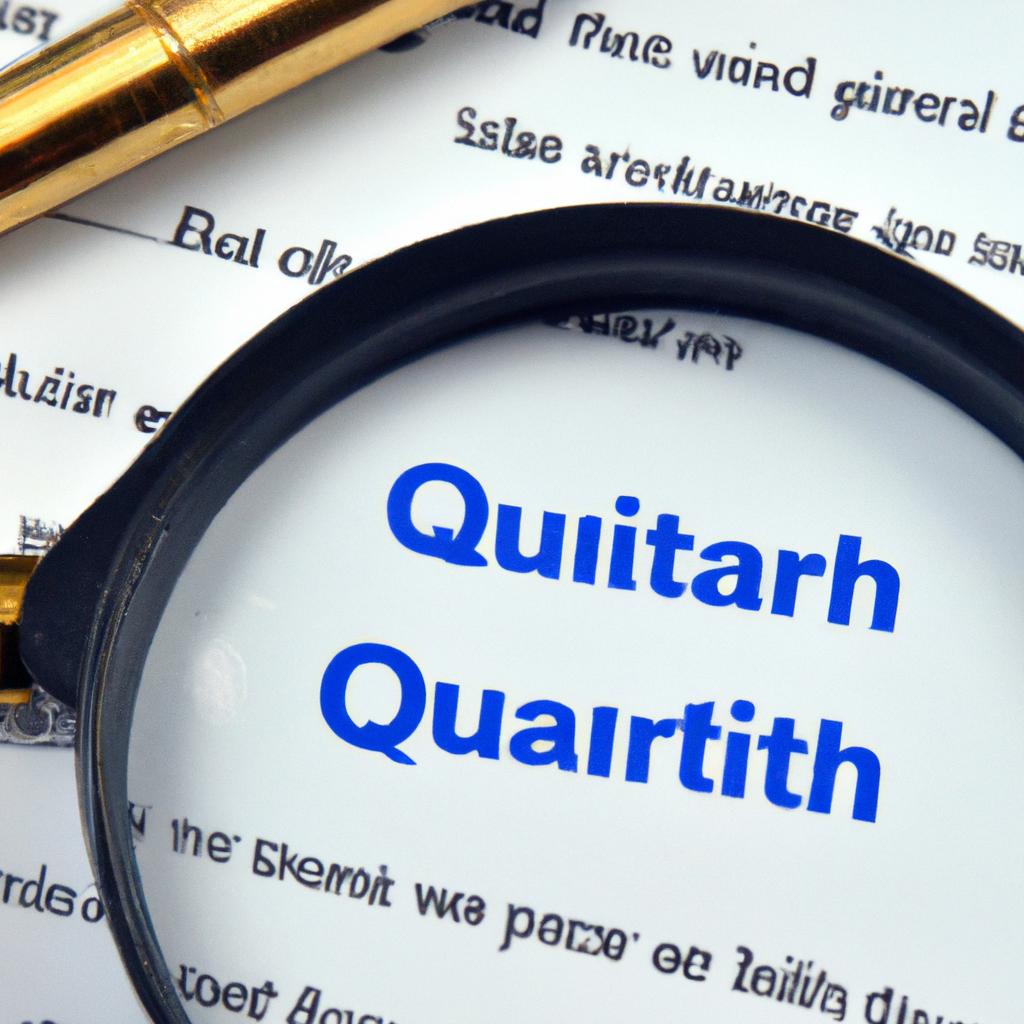In the intricate realm of real estate transactions, a record quitclaim holds a unique significance. As seasoned legal practitioners at Morgan Legal Group in the bustling metropolis of New York City, we understand the complexities and nuances involved in navigating the landscape of property transfers. Join us as we delve into the intricate details of record quitclaims, shedding light on the intricacies of this essential legal mechanism.
How to Properly Draft a Record Quitclaim Deed
When it comes to drafting a record quitclaim deed, there are several important steps that need to be followed to ensure that the document is legally binding and effective. First and foremost, it is crucial to accurately identify the parties involved in the transaction. This includes the grantor, who is the individual transferring their interest in the property, and the grantee, who is the recipient of that interest. Make sure to include their full legal names and addresses to avoid any confusion or disputes in the future.
Next, clearly describe the property that is being transferred in the deed. This should include the full address of the property, as well as a detailed legal description to accurately identify the boundaries of the land. Additionally, outline any rights or restrictions that may be associated with the property, such as easements or encumbrances. By following these steps and ensuring that the document is properly executed and recorded, you can help protect the interests of all parties involved in the transaction.

The Importance of Conducting a Title Search Before Using a Quitclaim Deed
When utilizing a quitclaim deed in real estate transactions, it is imperative to conduct a thorough title search beforehand to ensure all necessary information is disclosed and accounted for. This vital step helps to protect both parties involved in the transfer of property and can prevent potential legal issues or disputes down the line.
By conducting a title search before proceeding with a quitclaim deed, you can:
- Identify any existing liens or encumbrances on the property
- Confirm ownership of the property and any potential heirs or co-owners
- Discover any easements or restrictions that may affect the property

Key Differences Between a Quitclaim Deed and a Warranty Deed
When it comes to transferring real estate property, understanding the is essential to making an informed decision. Both types of deeds serve different purposes and offer varying levels of protection to the grantee.
A quitclaim deed is a type of deed that transfers whatever interest the grantor has in the property to the grantee. This means that the grantor makes no guarantees about the title to the property and does not guarantee that they have clear ownership rights. On the other hand, a warranty deed provides the grantee with certain guarantees, such as the grantor’s ownership of the property, the absence of any liens or encumbrances, and the promise to defend the title against any legal claims.

Recommendations for Ensuring the Validity of a Record Quitclaim Deed
When dealing with a record quitclaim deed, it is crucial to follow certain recommendations to ensure the validity of the document. Here are some key steps to consider:
- Verify the Grantor’s Identity: It is essential to confirm the identity of the individual or entity transferring the property through the quitclaim deed. This can be done by checking government-issued identification documents.
- Review Property Description: Double-check the accuracy of the property description provided in the deed. Any errors or discrepancies in the legal description can lead to complications in the future.
Additionally, it is advisable to consult with a legal professional experienced in real estate transactions to ensure all necessary steps are taken to validate the record quitclaim deed properly.
Q&A
Q: What is a record quitclaim?
A: A record quitclaim is a legal document used to transfer ownership of property from one party to another without any guarantees or warranties.
Q: How is a record quitclaim different from a traditional deed?
A: Unlike a traditional deed, a record quitclaim does not guarantee that the property being transferred is free of any liens or encumbrances. It simply transfers whatever interest the grantor has in the property to the grantee.
Q: When would a record quitclaim be used?
A: A record quitclaim is typically used in situations where the parties involved are familiar with each other and there is no need for a warranty of title. It may also be used to clarify ownership of a property or to settle disputes between family members.
Q: What are the advantages of using a record quitclaim?
A: One of the main advantages of using a record quitclaim is that it is a relatively simple and straightforward way to transfer ownership of property. It can also be used to quickly resolve ownership issues without the need for a lengthy legal process.
Q: Are there any risks associated with using a record quitclaim?
A: While a record quitclaim can be a convenient way to transfer property, it does not provide the same level of protection as a traditional deed. It is important to conduct a title search before using a record quitclaim to ensure that the property is free of any liens or other encumbrances.
To Wrap It Up
In conclusion, the record quitclaim process can be a valuable tool for transferring property rights quickly and efficiently. By understanding the implications and following the necessary steps, individuals can navigate this legal procedure with confidence. Whether you are a buyer or a seller, having a clear understanding of record quitclaim can help streamline the property transfer process and ensure a smooth transition of ownership. Be sure to consult with a legal professional for guidance on specific situations and to maximize the benefits of utilizing record quitclaim. Thank you for reading and best of luck in all your property transactions!
 Record Quitclaim: Understanding its Importance and How to Do it Properly
Record Quitclaim: Understanding its Importance and How to Do it Properly
When it comes to real estate transactions, there are many legal terms and procedures that can be confusing for buyers and sellers alike. One of these is the concept of “record quitclaim.” This article will delve into what record quitclaim is, why it is important, and how to properly execute it. By the end of this article, you will have a better understanding of this critical aspect of real estate transactions.
So, what exactly is record quitclaim? Essentially, it is a legal document that transfers ownership interest in a piece of property from one party to another. This can be used in various scenarios, such as when a family member is transferring their property to another family member or when a couple is going through a divorce and needs to divide their shared property. In simpler terms, it is a way to legally change the ownership of a property from one person to another, without any warranties or guarantees.
Now that we have a basic understanding of what record quitclaim is, let’s take a closer look at why it is important in real estate transactions.
Importance of Record Quitclaim
1. Property Ownership Transfer: The most obvious reason for executing a record quitclaim is to transfer ownership interest in a property. This is necessary when parties want to change the legal ownership of a property without selling it on the open market. This can save time and money in the long run, as it eliminates the need for a real estate agent and other professionals involved in a traditional sale.
2. Avoiding Potential Legal Issues: By recording a quitclaim, both parties involved in the transaction are legally protected. It ensures that there are no future disputes or claims made by either party regarding the ownership of the property. In traditional sales, buyers are often advised to conduct a title search to ensure there are no legal issues with the property they are purchasing. However, in a quitclaim scenario, the buyer is taking ownership “as is,” and any issues with the property will be their responsibility.
3. Transferring Property Ownership Between Family Members: Record quitclaim is often used in situations where family members are transferring ownership of a property. For example, if a parent wants to transfer ownership of their home to their child, a record quitclaim can be used to legally execute this transfer without the need for a traditional sale. This can be a more straightforward and cost-effective option for families looking to transfer property between generations.
4. Changing Property Ownership During Divorce: In the case of divorce, a record quitclaim can be used to transfer ownership of a shared property from one spouse to the other. This is especially useful when one spouse is keeping the property, and the other is relinquishing their ownership interest. Without a record quitclaim, both parties would still be legally responsible for the property, even after the divorce is finalized.
4. Removing a Co-owner’s Name from a Property: In situations where one party wants to remove their name from a property’s title, a record quitclaim can be used to officially transfer ownership. This can happen when siblings inherit a property from their parents and one sibling wants to relinquish their ownership interest. A record quitclaim can also be used when a couple wants to remove one spouse’s name from the property’s title.
How to Properly Execute a Record Quitclaim
Now that we understand why record quitclaim is important, let’s look at how to properly execute it.
1. Prepare the Quitclaim Deed: The first step in executing a record quitclaim is to prepare the deed, which is necessary for transferring ownership interest in the property. This document must contain the names and addresses of the parties involved, a detailed description of the property, and the terms of the transfer. It is important to ensure that the document is accurate and error-free to avoid any potential legal issues in the future.
2. Get the Deed Notarized: Once the quitclaim deed is prepared, it must be notarized to make it legally binding. This means that the signatures of all parties involved must be witnessed and verified by a notary public. This step adds an extra layer of protection and helps prevent any fraudulent activity.
3. Record the Deed with the County: After the deed is notarized, it must be recorded with the county clerk’s office, where the property is located. This ensures that the transfer of ownership is legally recognized and protects the interests of both parties involved. Recording fees may apply, so it’s essential to check with the county clerk’s office beforehand.
Best Practices for Record Quitclaim
1. Consult a Real Estate Attorney: While it is possible to execute a record quitclaim without the help of an attorney, it is always advisable to consult a real estate attorney to ensure that all legal aspects are covered and to avoid any potential issues in the future.
2. Conduct a Title Search: As mentioned earlier, a quitclaim does not come with any warranties or guarantees, so it’s essential to conduct a title search to ensure there are no legal issues with the property. This can help prevent any future disputes or claims made by either party.
3. Keep Accurate Property Records: It is crucial to maintain accurate records of the property in question, including all legal documents and transactions involved. This will help in case any discrepancies or issues arise in the future.
Conclusion
Record quitclaim is an essential aspect of real estate transactions, and understanding its importance and how to properly execute it can save both parties time and money in the long run. Whether you are transferring ownership of a property between family members or going through a divorce, consulting a real estate attorney and conducting proper due diligence can help ensure a smooth and legally binding transfer of ownership. Keep accurate records of the property and any legal documents involved to avoid any potential disputes or claims in the future. By following these best practices, you can confidently execute a record quitclaim and make informed decisions about your real estate transactions.

